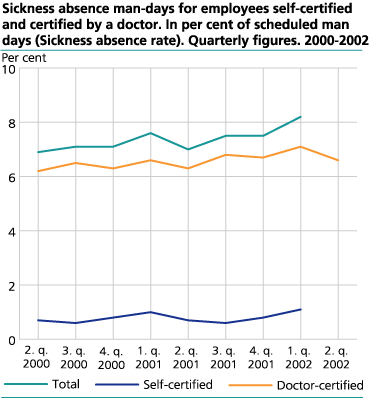Content
Published:
This is an archived release.
Slight change in self-certified sickness absences
The total sickness absence rate was 8.2 per cent in the 1s t quarter 2002, of which 1.1 per cent were self-certified and 7.1 doctor-certified absences. The self-certified absence rate increased by 0.1 percentage point compared with the corresponding quarter last year.
When comparing the 1s t quarter in 2001 and 2002, the time-series shows that the self-certified sickness absence rate have remained stable. Since the 2n d quarter 2001 the annual increase has been 0.1 percentage points. The 0.5 percentage points increase in total absences from the 1s t quarter 2001 to the 1s t quarter 2002 corresponds to an annual growth of 6.6 per cent. The figures have been adjusted for the fact that Easter fell in the first quarter in 2002 and in the second quarter in 2001.
Health and social work highest self-certified sickness absence
The self-certified sickness absence varies less between industries than the sickness absence certified by a doctor. The section health and social work had the highest self-certified sickness absence, with an absence rate of 1.3 per cent in the 1s t quarter 2002. The section with the highest increase from the 1s t quarter 2001 to the 1s t quarter 2002 was financial intermediation with 0.3 percentage points.
Women have higher sickness absence
Compared with men, women both have higher self-certified sickness absence (1.2 vs. 1.0 per cent) and sickness absence certified by a doctor (8.8 vs. 5.7 per cent). Sickness absence regarding pregnancy may explain some of the differences in sickness absence certified by a doctor.
Increased maximum period of self-certification
Lately many enterprises have opened for a change in the maximum period of self-certified sickness absence from 3 to 8 consecutive calendar days. A transfer of sickness absence from doctor-certified to self-certified sickness absence may be the result. No noticeable changes in the figures have been reported so far.
New sickness absence statistics
For the first time Statistics Norway now presents figures for self-certified sickness absence. Together with earlier published figures for sickness absence certified by a doctor - total sickness absence statistics are published. The new statistics cover all employees 16-69 years of age. An important term in these statistics is the sickness absence rate , which is defined as the number of man-days lost due to sickness absence as a percentage of all scheduled man-days.
The figures for self-certified sickness absence are based on a survey where around 10 000 establishments were randomly sampled. The figures of absences certified by doctors are based on a register of all doctor-certified sickness absences, and are produced in cooperation with the National Insurance Administration (RTV).
More detailed statistics on sickness absences of more than three days certified by a doctor are available on our web site: http://www.ssb.no/sykefra_en/ .
Tables:
- Table 1 Sickness absence man-days for employees self-certified and certified by a doctor. In per cent of scheduled man-days (Sickness absence rate). Quarterly figures. 2000-2002
- Table 2 Sickness absence man-days for employees self-certified and certified by a doctor, by sex. In per cent of scheduled man days (Sickness absence rate). Quarterly figures. 2000-2002
- Table 3 Sickness absence man-days for employees self-certified and certified by a doctor, by industry and type of sickness absence. In per cent of scheduled man days (Sickness absence rate). Quarterly figures. 2000-2002
Contact
-
Arbeidsmarked og lønn
E-mail: arbeidsmarked@ssb.no
-
Unn H. Høydahl
E-mail: unnh.hoydahl@ssb.no
tel.: (+47) 40 90 23 77

